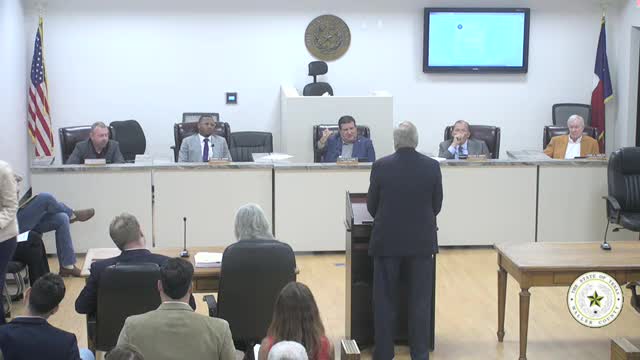Waller County votes 4‑1 to engage TxDOT and consultants on proposed 36A corridor study and public outreach
April 30, 2025 | Waller County, Texas
This article was created by AI summarizing key points discussed. AI makes mistakes, so for full details and context, please refer to the video of the full meeting. Please report any errors so we can fix them. Report an error »

Waller County Commissioners Court voted 4‑1 to authorize county staff to engage with the Texas Department of Transportation (TxDOT) and potential third‑party consultants on route evaluation, public engagement and impacts for the proposed north–south corridor commonly referred to as “36A.” The motion was amended on the floor to specify engagement for public engagement and route alignment study; the amended motion carried 4‑1.
James Cotsch of AIG Tech, a consultant the court was told TxDOT has retained for the North‑End Environmental Impact Statement (EIS) process, briefed the court on the EIS timeline and steps. Cotsch said the “EIS process is very structured, and you go through these steps and you can't move till you get that step done, and then you then you move on to the next step.” He told commissioners that the southern portion has already formally kicked off and that TxDOT plans the North‑End study to begin around the state fiscal‑year process; consultants expect to reach a 30 percent design (environmental/engineering baseline) within roughly a three‑year pipeline under TxDOT scheduling.
Commissioners and staff raised concerns about timing, county leverage and potential long lead times for design and right‑of‑way acquisition. Several commissioners said they feared losing negotiating leverage if state law or process limits county design standards and if the corridor’s alignment were fixed before county concerns about drainage and utility coordination are resolved. Staff and commissioners discussed opportunities — if the corridor proceeds — to coordinate drainage, utilities and regional detention using the corridor right‑of‑way, and to integrate county master drainage planning.
The court’s amended motion directs staff to engage with TxDOT and third‑party firms to explore alignment alternatives and to design a public engagement process. The court recorded a 4‑1 vote on the amendment and final motion (motion carries 4 to 1). The dissenting commissioner cautioned that formally engaging could be read as an endorsement of a particular alignment and emphasized the need for more public outreach before committing county resources.
Ending: County staff said they will compile a stakeholder list, coordinate meetings with TxDOT and provide options for how the county might fund or participate in any corridor study work; specific funding requests would return to the court for approval.
James Cotsch of AIG Tech, a consultant the court was told TxDOT has retained for the North‑End Environmental Impact Statement (EIS) process, briefed the court on the EIS timeline and steps. Cotsch said the “EIS process is very structured, and you go through these steps and you can't move till you get that step done, and then you then you move on to the next step.” He told commissioners that the southern portion has already formally kicked off and that TxDOT plans the North‑End study to begin around the state fiscal‑year process; consultants expect to reach a 30 percent design (environmental/engineering baseline) within roughly a three‑year pipeline under TxDOT scheduling.
Commissioners and staff raised concerns about timing, county leverage and potential long lead times for design and right‑of‑way acquisition. Several commissioners said they feared losing negotiating leverage if state law or process limits county design standards and if the corridor’s alignment were fixed before county concerns about drainage and utility coordination are resolved. Staff and commissioners discussed opportunities — if the corridor proceeds — to coordinate drainage, utilities and regional detention using the corridor right‑of‑way, and to integrate county master drainage planning.
The court’s amended motion directs staff to engage with TxDOT and third‑party firms to explore alignment alternatives and to design a public engagement process. The court recorded a 4‑1 vote on the amendment and final motion (motion carries 4 to 1). The dissenting commissioner cautioned that formally engaging could be read as an endorsement of a particular alignment and emphasized the need for more public outreach before committing county resources.
Ending: County staff said they will compile a stakeholder list, coordinate meetings with TxDOT and provide options for how the county might fund or participate in any corridor study work; specific funding requests would return to the court for approval.
View full meeting
This article is based on a recent meeting—watch the full video and explore the complete transcript for deeper insights into the discussion.
View full meeting
